U MEDIA Communications WRT383UV2 2.4GHz Wireless 802.11n(DRAFT) Router User Manual User s manual
U-MEDIA Communications, Inc. 2.4GHz Wireless 802.11n(DRAFT) Router User s manual
Manual
2.4GHz Wireless 802.11n(DRAFT) Router
WRT-383U V1.1
Rev 0.9
User Manual
1
Federal Communication Commission Interference Statement
This equipment has been tested and found to comply with the limits for a Class B digital
device, pursuant to Part 15 of the FCC Rules. These limits are designed to provide
reasonable protection against harmful interference in a residential installation. This
equipment generates, uses and can radiate radio frequency energy and, if not installed
and used in accordance with the instructions, may cause harmful interference to radio
communications. However, there is no guarantee that interference will not occur in a
particular installation. If this equipment does cause harmful interference to radio or
television reception, which can be determined by turning the equipment off and on, the
user is encouraged to try to correct the interference by one of the following measures:
- Reorient or relocate the receiving antenna.
- Increase the separation between the equipment and receiver.
- Connect the equipment into an outlet on a circuit different from that to which the
receiver is connected.
- Consult the dealer or an experienced radio/TV technician for help.
FCC Caution: Any changes or modifications not expressly approved by the party
responsible for compliance could void the user's authority to operate this equipment.
This device complies with Part 15 of the FCC Rules. Operation is subject to the following
two conditions: (1) This device may not cause harmful interference, and (2) this device
must accept any interference received, including interference that may cause undesired
operation.
IMPORTANT NOTE:
FCC Radiation Exposure Statement:
This equipment complies with FCC radiation exposure limits set forth for an uncontrolled
environment. This equipment should be installed and operated with minimum distance
20cm between the radiator & your body.
This transmitter must not be co-located or operating in conjunction with any other antenna
or transmitter.
The availability of some specific channels and/or operational frequency bands are country
dependent and are firmware programmed at the factory to match the intended destination.
The firmware setting is not accessible by the end user.
2
Industry Canada statement:
This device complies with RSS-210 of the Industry Canada Rules. Operation is subject to
the following two conditions:
(1) This device may not cause harmful interference, and (2) this device must accept any
interference received, including interference that may cause undesired operation.
IMPORTANT NOTE:
Radiation Exposure Statement:
This equipment complies with IC radiation exposure limits set forth for an uncontrolled
environment. This equipment should be installed and operated with minimum distance
20cm between the radiator & your body.
Copyright
This publication, including all photographs, illustrations and software, is protected under interna-
tional copyright laws, with all rights reserved. Neither this manual, nor any of the material con-
tained herein, may be reproduced without written consent of the author.
Copyright 2006
Trademark recognition
All product names used in this manual are the properties of their respective owners and are
acknowledged.
3
Table of Contents
Getting Started with the WRT-383U V1.1
Package Contents
Minimum System Requirements
Wireless LAN Networking
Introduction
Features
Hardware Overview
LED Indications
Rear Panel
Installation Considerations
Getting Started
Using the Configuration Menu
Basic
Advanced
Tools
Status
Glossary

4
Getting Started with the WRT-383U v1.1
Congratulations on purchasing the WRT-383U V1.1! This manual provides information for setting
up and configuring the WRT-383U V1.1. This manual is intended for both home users and
professionals.
Package Contents
WRT-383U V1.1 11n(Draft) Wireless Router
CAT-5 Ethernet Cable (All the WRT-383U V1.1’s Ethernet ports are Auto-MDIX)
Power Adapter (12V, 1A)
CD-ROM with Software and Manual
Quick Installation Guide
Using a power supply with a different voltage than the one included with your
product will cause damage and void the warranty for this product.
Minimum System Requirements
Ethernet-Based Cable or DSL Modem
Computers with Windows, Macintosh, or Linux-based operating systems with an installed
Ethernet adapter and CD-ROM Drive
Internet Explorer Version 6.0 or Netscape Navigator Version 7.0 and Above
5
Wireless LAN Networking
This section provides background information on wireless LAN networking technology. Consult
the Glossary for definitions of the terminology used in this section.
T
HE INFORMATION IN THIS SECTION IS FOR YOUR REFERENCE.
C
HANGING
NETWORK SETTINGS AND PARTICULARLY SECURITY SETTTINGS SHOULD ONLY
BE DONE BY AN AUTHORIZED ADMINISTRATOR.
Transmission Rate (Transfer Rate)
The WRT-383U V1.1 provides various transmission (data) rate options for you to select. In most
networking scenarios, the factory default Best (automatic) setting proves the most efficient. This
setting allows your WRT-383U V1.1 to operate at the maximum transmission (data) rate. When the
communication quality drops below a certain level, the WRT-383U V1.1 automatically switches to
a lower transmission (data) rate. Transmission at lower data speeds is usually more reliable.
However, when the communication quality improves again, the WRT-383U V1.1 gradually
increases the transmission (data) rate again until it reaches the highest available transmission
rate.
Types of Wireless Networks
Wireless LAN networking works in either of the two modes: ad-hoc and infrastructure. In infra-
structure mode, wireless devices communicate to a wired LAN via access points. Each access
point and its wireless devices are known as a Basic Service Set (BSS). An Extended Service Set
(ESS) is two or more BSSs in the same subnet. In ad hoc mode (also known as peer-to-peer
mode), wireless devices communicate with each other directly and do not use an access point.
This is an Independent BSS (IBSS).
To connect to a wired network within a coverage area using access points, set the operation mode
to Infrastructure (BSS). To set up an independent wireless workgroup without an access point, use
Ad-hoc (IBSS) mode.
A
D
-H
OC
(IBSS) N
ETWORK
Ad-hoc mode does not require an access point or a wired network. Two or more wireless stations
communicate directly to each other. An ad-hoc network may sometimes be referred to as an
Independent Basic Service Set (IBSS).
To set up an ad-hoc network, configure all the stations in ad-hoc mode. Use the same SSID and
6
channel for each station.
7
When a number of wireless stations are connected using a single access point, you have a Basic
Service Set (BSS).
In the ESS diagram below, communication is done through the access points, which relay data
packets to other wireless stations or devices connected to the wired network. Wireless stations
can then access resources, such as a printer, on the wired network.
8
In an ESS environment, users are able to move from one access point to another without losing the
connection. In the diagram below, when the user moves from BSS (1) to BSS (2) the WLAN client
devices automatically switches to the channel used in BSS (2).
Roaming in an ESS network diagram
9
Introduction
The WRT-383U V1.1 11n (Draft) Wireless Router is an high-performance, wireless router that
supports high-speed wireless networking at home, at work or in public places.
Unlike most routers, the WRT-383U V1.1 provides data transfers at up to 300Mbps when using 11n
(Draft) connection. This router is also back compatible with 802.11g or 11b devices. This means that
you do not need to change your entire network to maintain connectivity. You may sacrifice some of
11n’s (Draft) speed when you mix 11n (Draft) and 11b/g devices, but you will not lose the ability to
communicate when you incorporate the 11n (Draft) standard into your 11b/g network. You may
choose to slowly change your network by gradually replacing the 11b/g devices with 11n (Draft)
devices.
Features
Wi-Fi Compliant with IEEE 802.11n (draft) and IEEEE 802.11b/g Standards
2.412 to 2.472 GHz frequency band operation. (FCC: 2.412 to 2.462)
Compliant with IEEE 802.3 & 3u standards
Support OFDM and CCK modulation
High-Speed up to 300Mbps Data Rate using IEEE 802.11n (draft) connection
UPnP IGD 1.0 standard compliant
Work with Windows Vista compliant
Wi-Fi 11b/g and WMM certification compliant
64/128-bits WEP and WPA/WPA2 Personal/Enterprise security support
Wi-Fi Protection Setup compliant
NAT Support 4K~6K configurable NAT entries, Restricted NAPT, IP address ranges, port ranges &
schedule, Pre-defined game hosting configurations and Port triggering for special applications
ALG support RTP/RTSP, AOL, FTP, ICMP, WMP/MMS, NetMeeting, SIP.
Support IPSec, PPTP, L2TP and PPPoE pass-through
Firewall support Stateful Packet Inspection (SPI) and up to 24 rules for rule-based Firewall
Support Streaming Engine to accelerate the LAN to WAN traffic by Automatic traffic classification
& prioritization
Support configurable virtual servers & game servers and DMZ host
10
Support Static routing – RIPv1 announcer
Support Static or WAN assigned DNS servers and 10 verified services for DDNS
DHCP Server Support up to 252 leases, and up to 24 reservations
MAC address filtering support up to 24 filtering entries
Support WEB UI management, firmware upgrade and configuration backup and restore via
WLAN/LAN/WAN
Support 4 x 10/100Mbps Auto-MDIX LAN Port and 1 x 10/100Mbps WAN Port (Internet)
Built-in 2 External Antennas to support high speed performance and great coverage
11
Hardware Overview
LED Indications:
PWR
LAN1
LAN2
LAN3
LAN4
WAN
WLAN
WPS
USB
Rear panel:
DC-IN
RESET
Power switch
WLAN (ON/OFF)
WAN
LAN1
LAN2
12
LAN3
LAN4
Side Button:
WPS push button
Signal strength button
USB port
Installation Considerations
The WRT-383U V1.1 11n (Draft) Wireless Router lets you access your network, using a wireless
connection, from virtually anywhere within its operating range. Keep in mind, however, that the
number, thickness and location of walls, ceilings, or other objects that the wireless signals must pass
through, may limit the range. Typical ranges vary depending on the types of materials and background
RF (radio frequency) noise in your home or business. The key to maximizing wireless range is to
follow these basic guidelines:
1 Keep the number of walls and ceilings between the WRT-383U V1.1 and other network
devices to a minimum - each wall or ceiling can reduce your wireless product’s range from
3-90 feet (1-30 meters.) Position your devices so that the number of walls or ceilings is
minimized.
2 Be aware of the direct line between network devices. A wall that is 1.5 feet thick (.5 meters), at
a 45-degree angle appears to be almost 3 feet (1 meter) thick. At a 2-degree angle it looks
over 42 feet (14 meters) thick! Position devices so that the signal will travel straight through a
wall or ceiling (instead of at an angle) for better reception.
3 Building Materials can impede the wireless signal - a solid metal door or aluminum studs may
have a negative effect on range. Try to position wireless devices and computers with wireless
adapters so that the signal passes through drywall or open doorways and not other materials.
4 Keep your product away (at least 3-6 feet or 1-2 meters) from electrical devices or appliances
13
that generate extreme RF noise.
Getting Started
For a typical wireless setup at home, please do the following:
1. You will need broadband Internet access (a Cable or DSL-subscriber line into your home or
office)
2. Consult with your Cable or DSL provider for proper installation of the modem.
3. Connect the Cable or DSL modem to the WRT-383U V1.1 Wireless Broadband Router
(WAN port).
4. Ethernet LAN ports of the WRT-383U V1.1 are Auto MDI/MDIX and will work with both
Straight-Through and Cross-Over cable.
Using the Configuration Menu
Whenever you want to configure your WRT-383U V1.1, you can access the Configuration Menu
through your PC by opening the Web-browser and typing in the IP Address of the WRT-383U V1.1.
The WRT-383U V1.1’s default IP Address is http://192.168.0.1
Open the Web browser.
Type in the IP Address of the Router (http://192.168.0.1).

14
If you have changed the default IP Address assigned to the WRT-383U V1.1, make sure
to enter the correct IP Address.
Select admin in the User Name field.
Leave the Password blank.
Click Login In.
15
Basic
The Basic tab provides the following configuration options: Internet Connection, Wireless Settings,
Network Settings
Basic_
Internet Connection
Internet Connection Setup Wizard
If you are new to networking and have never configured a router before, click on
Setup Wizard
and the router will
guide you through a few simple steps to get your network up and running.
Manual Internet Connection Setup
If you consider yourself an advanced user and have configured a router before, click
Manual Configure
to input all
the settings manually.
16
Basic_
Wireless Settings
The wireless section is used to configure the wireless settings for your router. Note that changes made
in this section may also need to be duplicated on wireless clients that you want to connect to your
wireless network.
To protect your privacy, use the wireless security mode to configure the wireless security features.
This device supports three wireless security modes including: WEP, WPA-Personal, and
WPA-Enterprise. WEP is the original wireless encryption standard. WPA provides a higher level of
security. WPA-Personal does not require an authentication server. The WPA-Enterprise option does
require a RADIUS authentication server.
Enable Wireless
This option turns off and on the wireless connection feature of the router. When you set this option, the
following parameters are in effect.
Wireless Network Name
When you are browsing for available wireless networks, this is the name that will appear in the list (unless
Visibility Status is set to Invisible, see below). This name is also referred to as the SSID. For security
purposes, it is highly recommended to change from the pre-configured network name.
Enable Auto Channel Scan
If you select this option, the router automatically finds the channel with least interference and uses that
channel for wireless networking. If you disable this option, the router uses the channel that you specify with
the following Wireless Channel option.

17
Wireless Channel
A wireless network uses specific channels in the wireless spectrum to handle communication between clients.
Some channels in your area may have interference from other electronic devices. Choose the clearest
channel to help optimize the performance and coverage of your wireless network.
802.11 Mode
If all of the wireless devices you want to connect with this router can connect in the same transmission mode,
you can improve performance slightly by choosing the appropriate "Only" mode. If you have some devices
that use a different transmission mode, choose the appropriate "Mixed" mode.
Channel Width
The "Auto 20/40 MHz" option is usually best. The other options are available for special circumstances.
Transmission Rate
By default the fastest possible transmission rate will be selected. You have the option of selecting the speed if
necessary.
Number of Spatial Streams
Selecting more than one spatial stream can increase throughput, but can in some cases decrease signal
quality. Select the option that works best for your installation.
Visibility Status
The Invisible option allows you to hide your wireless network. When this option is set to Visible, your wireless
network name is broadcast to anyone within the range of your signal. If you're not using encryption then they
could connect to your network. When Invisible mode is enabled, you must enter the Wireless Network Name
(SSID) on the client manually to connect to the network.
Security Mode
Unless one of these encryption modes is selected, wireless transmissions to and from your wireless network
can be easily intercepted and interpreted by unauthorized users.
WEP
A method of encrypting data for wireless communication intended to provide the same level of privacy as a
wired network. WEP is not as secure as WPA encryption. To gain access to a WEP network, you must know
the key. The key is a string of characters that you create. When using WEP, you must determine the level of
encryption. The type of encryption determines the key length. 128-bit encryption requires a longer key than
64-bit encryption. Keys are defined by entering in a string in HEX (hexadecimal - using characters 0-9, A-F) or
ASCII (American Standard Code for Information Interchange - alphanumeric characters) format. ASCII format
is provided so you can enter a string that is easier to remember. The ASCII string is converted to HEX for use
over the network. Four keys can be defined so that you can change keys easily. A default key is selected for
use on the network.
Example:
64-bit hexadecimal keys are exactly 10 characters in length. (12345678FA is a valid string of 10 characters for
64-bit encryption.)
128-bit hexadecimal keys are exactly 26 characters in length. (456FBCDF123400122225271730 is a valid
string of 26 characters for 128-bit encryption.)
64-bit ASCII keys are up to 5 characters in length (DMODE is a valid string of 5 characters for 64-bit
encryption.)
128-bit ASCII keys are up to 13 characters in length (2002HALOSWIN1 is a valid string of 13 characters for
128-bit encryption.)
Note that, if you enter fewer characters in the WEP key than required, the remainder of the key is
automatically padded with zeros.
WPA-Personal and WPA-Enterprise

18
Both of these options select some variant of Wi-Fi Protected Access (WPA) -- security standards published by
the Wi-Fi Alliance. The WPA Mode further refines the variant that the router should employ.
WPA Mode: WPA is the older standard; select this option if the clients that will be used with the router only
support the older standard. WPA2 is the newer implementation of the stronger IEEE 802.11i security standard.
With the "WPA2" option, the router tries WPA2 first, but falls back to WPA if the client only supports WPA.
With the "WPA2 Only" option, the router associates only with clients that also support WPA2 security.
Cipher Type: The encryption algorithm used to secure the data communication. TKIP (Temporal Key Integrity
Protocol) provides per-packet key generation and is based on WEP. AES (Advanced Encryption Standard) is
a very secure block based encryption. With the "TKIP and AES" option, the router negotiates the cipher type
with the client, and uses AES when available.
Group Key Update Interval: The amount of time before the group key used for broadcast and multicast data
is changed.
WPA-Personal
This option uses Wi-Fi Protected Access with a Pre-Shared Key (PSK).
Pre-Shared Key: The key is entered as a pass-phrase of up to 63 alphanumeric characters in ASCII
(American Standard Code for Information Interchange) format at both ends of the wireless connection. It
cannot be shorter than eight characters, although for proper security it needs to be of ample length and should
not be a commonly known phrase. This phrase is used to generate session keys that are unique for each
wireless client.
Example:
Wireless Networking technology enables ubiquitous communication
WPA-Enterprise
This option works with a RADIUS Server to authenticate wireless clients. Wireless clients should have
established the necessary credentials before attempting to authenticate to the Server through this Gateway.
Furthermore, it may be necessary to configure the RADIUS Server to allow this Gateway to authenticate
users.
Authentication Timeout: Amount of time before a client will be required to re-authenticate.
RADIUS Server IP Address: The IP address of the authentication server.
RADIUS Server Port: The port number used to connect to the authentication server.
RADIUS Server Shared Secret: A pass-phrase that must match with the authentication server.
MAC Address Authentication: If this is selected, the user must connect from the same computer whenever
logging into the wireless network.
Advanced:
Optional Backup RADIUS Server
This option enables configuration of an optional second RADIUS server. A second RADIUS server can be
used as backup for the primary RADIUS server. The second RADIUS server is consulted only when the
primary server is not available or not responding. The fields Second RADIUS Server IP Address, RADIUS
Server Port, Second RADIUS server Shared Secret, Second MAC Address Authentication provide the
corresponding parameters for the second RADIUS Server.
19
Basic_Network Settings
20
WAN Port Mode
This option controls how the device reacts to traffic on the WAN connector. In this case the term "port"
refers to the Ethernet connectors on the device.
Router Mode
Select this option if the WAN port is connected to the Internet. The device functions as a NAT router.
Bridge Mode
Select this option if the device is connected to a local network downstream from another router. In this mode,
the device functions as a bridge between the network on its WAN port and the devices on its LAN port and
those connected to it wirelessly. The Router IP Address field below must be set to the IP address of this
device. The Gateway must be set to the IP address of the upstream router. Both addresses must be within
the LAN subnet as specified by Subnet Mask.
In bridge mode, the device still supports several features not available in ordinary bridges -- features that
involve the WAN side of the upstream router.
Firmware update checks
The bridge checks the support site for updates by way of the upstream router.
Log emails
When the log email option is set, log emails are sent to the Internet by way of the upstream router.
Internet rate estimation
The bridge still has the ability to analyze traffic on the WAN side of the upstream router so as to determine the
speed of its WAN connection.
StreamEngine
StreamEngine™ technology is applied to media streams that are passed between the WAN side of the
upstream router and clients of the bridge.
Router Settings
These are the settings of the LAN (Local Area Network) interface for the router. The router's local
network (LAN) settings are configured based on the IP Address and Subnet Mask assigned in this
section. The IP address is also used to access this Web-based management interface. It is
recommended that you use the default settings if you do not have an existing network.
IP Address
The IP address of your router on the local area network. Your local area network settings are based on the
address assigned here. For example, 192.168.0.1.
Subnet Mask
The subnet mask of your router on the local area network.
Local Domain Name
This entry is optional. Enter a domain name for the local network. LAN computers will assume this domain
name when they get an address from the router's built in DHCP server. So, for example, if you enter
mynetwork.net
here, and you have a LAN side laptop with a name of
chris
, that laptop will be known
as
chris.mynetwork.net
. Note, however, the entered domain name can be overridden by the one
obtained from the router's upstream DHCP server.
DNS Relay
When DNS Relay is enabled, the router plays the role of a DNS server. DNS requests sent to the router are
forwarded to the ISP's DNS server. This provides a constant DNS address that LAN computers can use, even
when the router obtains a different DNS server address from the ISP upon re-establishing the WAN
connection. You should disable DNS relay if you implement a LAN-side DNS server as a virtual server.

21
If WAN Port Mode is set to "Bridge Mode", the following choices are displayed in place of the above choices,
because the device is functioning as a bridge in a network that contains another router.
Router IP Address
The IP address of the this device on the local area network. Assign any unused IP address in the range of IP
addresses available for the LAN. For example, 192.168.0.101.
Subnet Mask
The subnet mask of the local area network.
Gateway
The IP address of the router on the local area network. For example, 192.168.0.1.
Primary DNS Server, Secondary DNS Server
Enter the IP addresses of the DNS Servers. Leave the field for the secondary server empty if not used.
DHCP Server Settings
DHCP stands for Dynamic Host Configuration Protocol. The DHCP section is where you configure the built-in
DHCP Server to assign IP addresses to the computers and other devices on your local area network (LAN).
Enable DHCP Server
Once your router is properly configured and this option is enabled, the DHCP Server will manage the IP
addresses and other network configuration information for computers and other devices connected to your
Local Area Network. There is no need for you to do this yourself.
The computers (and other devices) connected to your LAN also need to have their TCP/IP configuration set to
"DHCP" or "Obtain an IP address automatically".
When you set Enable DHCP Server, the following options are displayed.
DHCP IP Address Range
These two IP values (from and to) define a range of IP addresses that the DHCP Server uses when assigning
addresses to computers and devices on your Local Area Network. Any addresses that are outside of this
range are not managed by the DHCP Server; these could, therefore, be used for manually configured devices
or devices that cannot use DHCP to obtain network address details automatically.
It is possible for a computer or device that is manually configured to have an address that does reside within
this range. In this case the address should be reserved (see DHCP Reservation below), so that the DHCP
Server knows that this specific address can only be used by a specific computer or device.
Your router, by default, has a static IP address of 192.168.0.1. This means that addresses 192.168.0.2 to
192.168.0.254 can be made available for allocation by the DHCP Server.
Example:
Your router uses 192.168.0.1 for the IP address. You've assigned a computer that you want to designate as a
Web server with a static IP address of 192.168.0.3. You've assigned another computer that you want to
designate as an FTP server with a static IP address of 192.168.0.4. Therefore the starting IP address for your
DHCP IP address range needs to be 192.168.0.5 or greater.
Example:
Suppose you configure the DHCP Server to manage addresses From 192.168.0.100 To 192.168.0.199. This
means that 192.168.0.3 to 192.168.0.99 and 192.168.0.200 to 192.168.0.254 are NOT managed by the
DHCP Server. Computers or devices that use addresses from these ranges are to be manually configured.
Suppose you have a web server computer that has a manually configured address of 192.168.0.100. Because
this falls within the "managed range" be sure to create a reservation for this address and match it to the
relevant computer (see Static DHCP Client below).
DHCP Lease Time
22
The amount of time that a computer may have an IP address before it is required to renew the lease. The
lease functions just as a lease on an apartment would. The initial lease designates the amount of time before
the lease expires. If the tenant wishes to retain the address when the lease is expired then a new lease is
established. If the lease expires and the address is no longer needed than another tenant may use the
address.
Always Broadcast
If all the computers on the LAN successfully obtain their IP addresses from the router's DHCP server as
expected, this option can remain disabled. However, if one of the computers on the LAN fails to obtain an IP
address from the router's DHCP server, it may have an old DHCP client that incorrectly turns off the broadcast
flag of DHCP packets. Enabling this option will cause the router to always broadcast its responses to all
clients, thereby working around the problem, at the cost of increased broadcast traffic on the LAN.
NetBIOS Advertisement
Check this box to allow the DHCP Server to offer NetBIOS configuration settings to the LAN hosts. NetBIOS
allows LAN hosts to discover all other computers within the network, e.g. within Network Neighbourhood.
Learn NetBIOS information from WAN
If NetBIOS advertisement is swicthed on, switching this setting on causes WINS information to be learned
from the WAN side, if available. Turn this setting off to configure manually.
Primary WINS Server IP address
Configure the IP address of the preferred WINS server. WINS Servers store information regarding network
hosts, allowing hosts to 'register' themselves as well as discover other available hosts, e.g. for use in Network
Neighbourhood. This setting has no effect if the 'Learn NetBIOS information from WAN' is activated.
Secondary WINS Server IP address
Configure the IP address of the backup WINS server, if any. This setting has no effect if the 'Learn NetBIOS
information from WAN' is activated.
NetBIOS Scope
This is an advanced setting and is normally left blank. This allows the configuration of a NetBIOS 'domain'
name under which network hosts operate. This setting has no effect if the 'Learn NetBIOS information from
WAN' is activated.
NetBIOS Registration mode
Indicates how network hosts are to perform NetBIOS name registration and discovery.
H-Node, this indicates a Hybrid-State of operation. First WINS servers are tried, if any, followed by local
network broadcast. This is generally the preferred mode if you have configured WINS servers.
M-Node (default), this indicates a Mixed-Mode of operation. First Broadcast operation is performed to register
hosts and discover other hosts, if broadcast operation fails, WINS servers are tried, if any. This mode favours
broadcast operation which may be preferred if WINS servers are reachable by a slow network link and the
majority of network services such as servers and printers are local to the LAN.
P-Node, this indicates to use WINS servers ONLY. This setting is useful to force all NetBIOS operation to the
configured WINS servers. You must have configured at least the primary WINS server IP to point to a working
WINS server.
B-Node, this indicates to use local network broadcast ONLY. This setting is useful where there are no WINS
servers available, however, it is preferred you try M-Node operation first.
This setting has no effect if the 'Learn NetBIOS information from WAN' is activated.
Add/Edit DHCP Reservation
This option lets you reserve IP addresses, and assign the same IP address to the network device with the
specified MAC address any time it requests an IP address. This is almost the same as when a device has a
static IP address except that the device must still request an IP address from the router. The router will
provide the device the same IP address every time. DHCP Reservations are helpful for server computers on
the local network that are hosting applications such as Web and FTP. Servers on your network should either
use a static IP address or use this option.
Computer Name

23
You can assign a name for each computer that is given a reserved IP address. This may help you keep track
of which computers are assigned this way. Example:
Game Server
.
IP Address:
The LAN address that you want to reserve.
MAC Address
To input the MAC address of your system, enter it in manually or connect to the router's Web-Management
interface from the system and click the
Copy Your PC's MAC Address
button.
A MAC address is usually located on a sticker on the bottom of a network device. The MAC address is
comprised of twelve digits. Each pair of hexadecimal digits are usually separated by dashes or colons such as
00-0D-88-11-22-33 or 00:0D:88:11:22:33. If your network device is a computer and the network card is
already located inside the computer, you can connect to the router from the computer and click the
Copy
Your PC's MAC Address
button to enter the MAC address.
As an alternative, you can locate a MAC address in a specific operating system by following the steps below:
Windows 98
Windows Me
Go to the Start menu, select Run, type in
winipcfg
, and hit Enter. A popup window
will be displayed. Select the appropriate adapter from the pull-down menu and you will
see the Adapter Address. This is the MAC address of the device.
Windows 2000
Windows XP
Go to your Start menu, select Programs, select Accessories, and select Command
Prompt. At the command prompt type
ipconfig /all
and hit Enter. The physical
address displayed for the adapter connecting to the router is the MAC address.
Mac OS X Go to the Apple Menu, select System Preferences, select Network, and select the
Ethernet Adapter connecting to the router. Select the Ethernet button and the Ethernet
ID will be listed. This is the same as the MAC address.
Enable
Specifies whether the entry will be active or inactive.
Save/Update
Record the changes you have made into the following list.
Clear
Re-initialize this area of the screen, discarding any changes you have made.
DHCP Reservations List
This shows clients that you have specified to have reserved DHCP addresses. Click the Enable checkbox at
the left to directly activate or de-activate the entry. An entry can be changed by clicking the Edit icon or can be
deleted by clicking the Delete icon. When you click the Edit icon, the item is highlighted, and the "Edit DHCP
Reservation" section is activated for editing.
Number of Dynamic DHCP Clients
In this section you can see what LAN devices are currently leasing IP addresses.
Revoke
The
Revoke
option is available for the situation in which the lease table becomes full or nearly full, you
need to recover space in the table for new entries, and you know that some of the currently allocated leases
are no longer needed. Clicking
Revoke
cancels the lease for a specific LAN device and frees an entry in the
lease table. Do this only if the device no longer needs the leased IP address, because, for example, it has
been removed from the network.
Reserve
The
Reserve
option converts this dynamic IP allocation into a DHCP Reservation and adds the
corresponding entry to the DHCP Reservations List.

24
Advanced
The Advanced tab provides the following configuration options: Virtual Server, Port Forwarding,
Application Rules, StreamEngine, Routing, Access Control, Website Filter, Network Filter, Firewall
Settings, Inbound Filter, Advanced Wireless, WISH, Wi-Fi Protected Setup, Advanced Network,
Advanced_Virtual Server
The Virtual Server option gives Internet users access to services on your LAN. This feature is useful
for hosting online services such as FTP, Web, or game servers. For each Virtual Server, you define a
public port on your router for redirection to an internal LAN IP Address and LAN port.
25
Example: You are hosting a Web Server on a PC that has LAN IP Address of 192.168.0.50 and your ISP
is blocking Port 80.
1. Name the Virtual Server (for example:
Web Server
)
2. Enter the IP Address of the machine on your LAN (for example:
192.168.0.50
3. Enter the Private Port as [80]
4. Enter the Public Port as [8888]
5. Select the Protocol (for example
TCP
).
6. Ensure the schedule is set to
Always
7. Click
Save
to add the settings to the Virtual Servers List
8. Repeat these steps for each Virtual Server Rule you wish to add.
With this Virtual Server entry, all Internet traffic on Port 8888 will be redirected to your internal web server
on port 80 at IP Address 192.168.0.50.
Add/Edit Virtual Server
Enable
Specifies whether the entry will be active or inactive.
Name
Assign a meaningful name to the virtual server, for example
Web Server
. Several well-known types of
virtual server are available from the "Application Name" drop-down list. Selecting one of these entries fills
some of the remaining parameters with standard values for that type of server.
IP Address

26
The IP address of the system on your internal network that will provide the virtual service, for example
192.168.0.50
. You can select a computer from the list of DHCP clients in the "Computer Name" drop-down
menu, or you can manually enter the IP address of the server computer.
Protocol
Select the protocol used by the service. The common choices -- UDP, TCP, and both UDP and TCP -- can be
selected from the drop-down menu. To specify any other protocol, select "Other" from the list, then enter the
corresponding protocol number (as assigned by the IANA) in the Protocol box.
Private Port
The port that will be used on your internal network.
Public Port
The port that will be accessed from the Internet.
Schedule
Select a schedule for when the service will be enabled. If you do not see the schedule you need in the list of
schedules, go to the Tools → Schedules screen and create a new schedule.
Inbound Filter
Select a filter that controls access as needed for this virtual server. If you do not see the filter you need in the
list of filters, go to the Advanced → Inbound Filter screen and create a new filter.
Save/Update
Record the changes you have made into the following list.
Clear
Re-initialize this area of the screen, discarding any changes you have made.
Virtual Server List
This is a list of the defined Virtual Servers. Click the Enable checkbox at the left to directly activate or
de-activate the entry. An entry can be changed by clicking the Edit icon or can be deleted by clicking the
Delete icon. When you click the Edit icon, the item is highlighted, and the "Edit Virtual Servers" section is
activated for editing.
Note: You might have trouble accessing a virtual server using its public identity (WAN-side IP-address of the gateway
or its dynamic DNS name) from a machine on the LAN. Your requests may not be looped back or you may be
redirected to the "Forbidden" page.
This will happen if you have an Access Control Rule configured for this LAN machine.
The requests from the LAN machine will not be looped back if Internet access is blocked at the time of access. To
work around this problem, access the LAN machine using its LAN-side identity.
Requests may be redirected to the "Forbidden" page if web access for the LAN machine is restricted by an Access
Control Rule. Add the WAN-side identity (WAN-side IP-address of the router or its dynamic DNS name) on the
Advanced → Web Filter screen to work around this problem.
27
Advanced_Special Applications
An application rule is used to open single or multiple ports on your router when the router senses data
sent to the Internet on a "trigger" port or port range. An application rule applies to all computers on
your internal network.
Add/Edit Application Rule
Example:
You need to configure your router to allow a software application running on any computer on your network to
connect to a web-based server or another user on the Internet.
Enable
Specifies whether the entry will be active or inactive.
Name
Enter a name for the Special Application Rule, for example
Game App
, which will help you identify the rule
in the future. Alternatively, you can select from the Application list of common applications.
Application
Instead of entering a name for the Special Application rule, you can select from this list of common
applications, and the remaining configuration values will be filled in accordingly.
Trigger Port
Enter the outgoing port range used by your application (for example
6500-6700
).
Trigger Traffic Type
Select the outbound protocol used by your application (for example
Both
).
Firewall Port
Enter the port range that you want to open up to Internet traffic (for example
6000-6200
).

28
Firewall Traffic Type
Select the protocol used by the Internet traffic coming back into the router through the opened port range (for
example
Both
).
Schedule
Select a schedule for when this rule is in effect. If you do not see the schedule you need in the list of
schedules, go to the Tools → Schedules screen and create a new schedule.
Save/Update
Record the changes you have made into the following list.
Clear
Re-initialize this area of the screen, discarding any changes you have made.
With the above example application rule enabled, the router will open up a range of ports from 6000-6200 for
incoming traffic from the Internet, whenever any computer on the internal network opens up an application
that sends data to the Internet using a port in the range of 6500-6700.
Application Rules
This is a list of the defined application rules. Click the Enable checkbox at the left to directly activate or
de-activate the entry. An entry can be changed by clicking the Edit icon or can be deleted by clicking the
Delete icon. When you click the Edit icon, the item is highlighted, and the "Edit Application Rule" section is
activated for editing.
Advanced_
Port Forwarding
Multiple connections are required by some applications, such as internet games, video conferencing,
Internet telephony, and others. These applications have difficulties working through NAT (Network
Address Translation). This section is used to open multiple ports or a range of ports in your router and
29
redirect data through those ports to a single PC on your network. You can enter ports in various
formats:
Range (50-100)
Individual (80, 68, 888)
Mixed (1020-5000, 689)
Example:
Suppose you are hosting an online game server that is running on a PC with a private IP Address of 192.168.0.50.
This game requires that you open multiple ports (6159-6180, 99) on the router so Internet users can connect.
Add/Edit Port Forwarding Rule
Use this section to add a Port Forwarding Rule to the following list or to edit a rule already in the list.
Enable
Specifies whether the entry will be active or inactive.
Name
Give the rule a name that is meaningful to you, for example
Game Server
. You can also select from a list
of popular games, and many of the remaining configuration values will be filled in accordingly. However, you
should check whether the port values have changed since this list was created, and you must fill in the IP
address field.
IP Address
Enter the local network IP address of the system hosting the server, for example
192.168.0.50
. You can
select a computer from the list of DHCP clients in the "Computer Name" drop-down menu, or you can
manually enter the IP address of the server computer.
TCP Ports

30
Enter the TCP ports to open (for example
6159-6180, 99
).
UDP Ports
Enter the UDP ports to open (for example
6159-6180, 99
).
Schedule
Select a schedule for the times when this rule is in effect. If you do not see the schedule you need in the list of
schedules, go to the Tools → Schedules screen and create a new schedule.
Inbound Filter
Select a filter that controls access as needed for this rule. If you do not see the filter you need in the list of
filters, go to the Advanced → Inbound Filter screen and create a new filter.
Save/Update
Record the changes you have made into the following list.
Clear
Re-initialize this area of the screen, discarding any changes you have made.
With the above example values filled in and this Port Forwarding Rule enabled, all TCP and UDP traffic on
ports 6159 through 6180 and port 99 is passed through the router and redirected to the Internal Private IP
Address of your Game Server at 192.168.0.50.
Note that different LAN computers cannot be associated with Port Forwarding rules that contain any ports in
common; such rules would contradict each other.
Port Forwarding Rules
This is a list of the defined Port Forwarding Rules. Click the Enable checkbox at the left to directly activate or
de-activate the entry. An entry can be changed by clicking the Edit icon or can be deleted by clicking the
Delete icon. When you click the Edit icon, the item is highlighted, and the "Edit Port Forwarding Rule" section
is activated for editing.
Advanced_
StreamEngine
The StreamEngine feature helps improve your network performance by prioritizing applications.
31
WAN Traffic Shaping
Enable Traffic Shaping
When this option is enabled, the router restricts the flow of outbound traffic so as not to exceed the WAN
uplink bandwidth.
Automatic Uplink Speed
When enabled, this option causes the router to automatically measure the useful uplink bandwidth each time
the WAN interface is re-established (after a reboot, for example).
Measured Uplink Speed
This is the uplink speed measured when the WAN interface was last re-established. The value may be lower
than that reported by your ISP as it does not include all of the network protocol overheads associated with
your ISP's network. Typically, this figure will be between 87% and 91% of the stated uplink speed for xDSL
connections and around 5 kbps lower for cable network connections.
Manual Uplink Speed
If Automatic Uplink Speed is disabled, this options allows you to set the uplink speed manually. Uplink speed
is the speed at which data can be transferred from the router to your ISP. This is determined by your ISP. ISPs

32
often specify speed as a downlink/uplink pair; for example, 1.5Mbps/284kbps. For this example, you would
enter "284". Alternatively you can test your uplink speed with a service such as www.dslreports.com. Note
however that sites such as DSL Reports, because they do not consider as many network protocol overheads,
will generally note speeds slightly lower than the Measured Uplink Speed or the ISP rated speed.
Connection Type
By default, the router automatically determines whether the underlying connection is an xDSL/Frame-relay
network or some other connection type (such as cable modem or Ethernet), and it displays the result as
Detected xDSL or Frame Relay Network. If you have an unusual network connection in which you are
actually connected via xDSL but for which you configure either "Static" or "DHCP" in the WAN settings, setting
this option to xDSL or Other Frame Relay Network ensures that the router will recognize that it needs to
shape traffic slightly differently in order to give the best performance. Choosing xDSL or Other Frame Relay
Network causes the measured uplink speed to be reported slightly lower than before on such connections,
but gives much better results.
Detected xDSL or Frame Relay Network
When Connection Type is set to Auto-detect, the automatically detected connection type is displayed here.
StreamEngine Setup
Enable StreamEngine
Enable this option for better performance and experience with online games and other interactive applications,
such as VoIP.
Automatic Classification
This option is enabled by default so that your router will automatically determine which programs should have
network priority. For best performance, use the Automatic Classification option to automatically set the priority
for your applications.
Dynamic Fragmentation
This option should be enabled when you have a slow Internet uplink. It helps to reduce the impact that large
low priority network packets can have on more urgent ones by breaking the large packets into several smaller
packets.
Add/Edit StreamEngine Rules
A StreamEngine Rule identifies a specific message flow and assigns a priority to that flow. For most
applications, automatic classification will be adequate, and specific StreamEngine Rules will not be required.
StreamEngine supports overlaps between rules, where more than one rule can match for a specific message
flow. If more than one rule is found to match the rule with the highest priority will be used.
Enable
Specifies whether the entry will be active or inactive.
Name
Create a name for the rule that is meaningful to you.
Priority
The priority of the message flow is entered here -- 0 receives the highest priority (most urgent) and 255
receives the lowest priority (least urgent).
Protocol
The protocol used by the messages.
Local IP Range
The rule applies to a flow of messages whose LAN-side IP address falls within the range set here.
Local Port Range

33
The rule applies to a flow of messages whose LAN-side port number is within the range set here.
Remote IP Range
The rule applies to a flow of messages whose WAN-side IP address falls within the range set here.
Remote Port Range
The rule applies to a flow of messages whose WAN-side port number is within the range set here.
Save/Update
Record the changes you have made into the following list.
Clear
Re-initialize this area of the screen, discarding any changes you have made.
StreamEngine Rules
This section lists all the defined StreamEngine Rules. Click the Enable checkbox at the left to directly activate
or de-activate the entry. An entry can be changed by clicking the Edit icon or can be deleted by clicking the
Delete icon. When you click the Edit icon, the item is highlighted, and the "Edit StreamEngine Rule" section is
activated for editing.
Advanced_Routing
34
Add/Edit Route
Adds a new route to the IP routing table or edits an existing route.
Enable
Specifies whether the entry will be enabled or disabled.
Destination IP
The IP address of packets that will take this route.
Netmask
One bits in the mask specify which bits of the IP address must match.
Gateway
Specifies the next hop to be taken if this route is used. A gateway of 0.0.0.0 implies there is no next hop, and
the IP address matched is directly connected to the router on the interface specified: LAN or WAN.
Metric
The route metric is a value from 1 to 16 that indicates the cost of using this route. A value of 1 is the lowest
cost, and 15 is the highest cost. A value of 16 indicates that the route is not reachable from this router. When
trying to reach a particular destination, computers on your network will select the best route, ignoring
unreachable routes.
Interface
Specifies the interface -- LAN or WAN -- that the IP packet must use to transit out of the router, when this
route is used.
Save/Update
Record the changes you have made into the following list.
Clear
Re-initialize this area of the screen, discarding any changes you have made.
Routes List
35
The section shows the current routing table entries. Certain required routes are predefined and cannot be
changed. Routes that you add can be changed by clicking the Edit icon or can be deleted by clicking the
Delete icon. When you click the Edit icon, the item is highlighted, and the "Edit Route" section is activated for
editing. Click the Enable checkbox at the left to directly activate or de-activate the entry.
36
Advanced_Access Control
The Access Control section allows you to control access in and out of devices on your network. Use
this feature as Parental Controls to only grant access to approved sites, limit web access based on
time or dates, and/or block access from applications such as peer-to-peer utilities or games.
Enable
By default, the Access Control feature is disabled. If you need Access Control, check this option.
Note: When Access Control is disabled, every device on the LAN has unrestricted access to the Internet.
However, if you enable Access Control, Internet access is restricted for those devices that have an Access
Control Policy configured for them. All other devices have unrestricted access to the Internet.
Policy Wizard
The Policy Wizard guides you through the steps of defining each access control policy. A policy is the
"Who, What, When, and How" of access control -- whose computer will be affected by the control, what
internet addresses are controlled, when will the control be in effect, and how is the control implemented.
You can define multiple policies. The Policy Wizard starts when you click the button below and also
when you edit an existing policy.
Add Policy
Click this button to start creating a new access control policy.
Policy Table
This section shows the currently defined access control policies. A policy can be changed by clicking the Edit
icon, or deleted by clicking the Delete icon. When you click the Edit icon, the Policy Wizard starts and guides
you through the process of changing a policy. You can enable or disable specific policies in the list by clicking
the "Enable" checkbox.
37
Advanced_WEB Filter
The Web sites listed here are used when the Web Filter option is enabled in Advanced → Access
Control.
Add Web Filtering Rule
This section is where you add the Web sites to be used for Access Control.
Website URL/Domain
Enter the URL (address) of the Web Site that you want to allow; for example:
google.com
. Do not enter
the
http://
preceding the URL. Enter the most inclusive domain; for example, enter
ubicom.com
and
access will be permitted to both
www.ubicom.com
and
support.ubicom.com
.
Save
Record the changes you have made into the following list.
Note: Many web sites construct pages with images and content from other web sites. Access will be forbidden
if you do not enable all the web sites used to construct a page. For example, to access
my.yahoo.com
,
you need to enable access to
yahoo.com
,
yimg.com
, and
doubleclick.net
.
Website Filtering Rules
The section lists the currently allowed web sites.
Advanced_
MAC Address Filter (Network Filter)
The MAC address filter section can be used to filter network access by machines based on the unique
MAC addresses of their network adapter(s). It is most useful to prevent unauthorized wireless devices
38
from connecting to your network. A MAC address is a unique ID assigned by the manufacturer of the
network adapter.
MAC Filtering Setup
Choose the type of MAC filtering needed.
Turn MAC Filtering OFF: When "OFF" is selected, MAC addresses are not used to control network access.
Turn MAC Filtering ON and ALLOW computers listed to access the network: When "ALLOW" is selected,
only computers with MAC addresses listed in the MAC Filtering Rules list are granted network access.
Turn MAC Filtering ON and DENY computers listed to access the network: When "DENY" is selected,
any computer with a MAC address listed in the MAC Filtering Rules list is refused access to the network.
Add MAC Filtering Rule
Use this section to add MAC addresses to the list below.
MAC Address
Enter the MAC address of a computer that you want to control with MAC filtering. Computers that have
obtained an IP address from the router's DHCP server will be in the DHCP Client List. Select a device from
the drop down menu.
Save
Record the changes you have made into the following list.
MAC Filtering Rules
This section lists the network devices that are under control of MAC filtering.
39
Advanced_
Firewall Settings
The router provides a tight firewall by virtue of the way NAT works. Unless you configure the router to
the contrary, the NAT does not respond to unsolicited incoming requests on any port, thereby making
your LAN invisible to Internet cyberattackers. However, some network applications cannot run with a
tight firewall. Those applications need to selectively open ports in the firewall to function correctly. The
options on this page control several ways of opening the firewall to address the needs of specific types
of applications. See also Advanced → Virtual Server, Advanced → Port Forwarding, Advanced →
Application Rules, and Advanced → Network (UPnP) for related options.

40
Firewall Settings
Enable SPI
SPI ("stateful packet inspection" also known as "dynamic packet filtering") helps to prevent cyberattacks by
tracking more state per session. It validates that the traffic passing through that session conforms to the
protocol. When the protocol is TCP, SPI checks that packet sequence numbers are within the valid range for
the session, discarding those packets that do not have valid sequence numbers.
Whether SPI is enabled or not, the router always tracks TCP connection states and ensures that each TCP
packet's flags are valid for the current state.
NAT Endpoint Filtering
The NAT Endpoint Filtering options control how the router's NAT manages incoming connection requests to
ports that are already being used.
Endpoint Independent
Once a LAN-side application has created a connection through a specific port, the NAT will forward any
incoming connection requests with the same port to the LAN-side application regardless of their origin. This is
the least restrictive option, giving the best connectivity and allowing some applications (P2P applications in
particular) to behave almost as if they are directly connected to the Internet.
Address Restricted
The NAT forwards incoming connection requests to a LAN-side host only when they come from the same IP
address with which a connection was established. This allows the remote application to send data back
through a port different from the one used when the outgoing session was created.
Port And Address Restricted
The NAT does not forward any incoming connection requests with the same port address as an already
establish connection.
Note that some of these options can interact with other port restrictions. Endpoint Independent Filtering takes
priority over inbound filters or schedules, so it is possible for an incoming session request related to an
outgoing session to enter through a port in spite of an active inbound filter on that port. However, packets will
be rejected as expected when sent to blocked ports (whether blocked by schedule or by inbound filter) for
which there are no active sessions. Port and Address Restricted Filtering ensures that inbound filters and
schedules work precisely, but prevents some level of connectivity, and therefore might require the use of port
triggers, virtual servers, or port forwarding to open the ports needed by the application. Address Restricted
Filtering gives a compromise position, which avoids problems when communicating with certain other types of
NAT router (symmetric NATs in particular) but leaves inbound filters and scheduled access working as
expected.
UDP Endpoint Filtering
Controls endpoint filtering for packets of the UDP protocol.
TCP Endpoint Filtering
Controls endpoint filtering for packets of the TCP protocol.
Formerly, the terms "Full Cone", "Restricted Cone", "Port Restricted Cone" and "Symmetric" were used to
refer to different variations of NATs. These terms are purposely not used here, because they do not fully
41
describe the behavior of this router's NAT. While not a perfect mapping, the following loose correspondences
between the "cone" classification and the "endpoint filtering" modes can be drawn: if this router is configured
for endpoint independent filtering, it implements full cone behavior; address restricted filtering implements
restricted cone behavior; and port and address restricted filtering implements port restricted cone behavior.
NAT Port Preservation
NAT Port preservation (on by default) tries to ensure that, when a LAN host makes an Internet connection, the
same LAN port is also used as the Internet visible port. This ensures best compatibility for internet
communications.
Under some circumstances it may be desirable to turn off this feature.
Anti-Spoof checking
Enabling this option can provide protection from certain kinds of "spoofing" attacks. However, enble this option
with care. With some modems, the WAN connection may be lost when this option is enabled. In that case, it
may be necessary to change the LAN subnet to something other than 192.168.0.x (192.168.2.x, for example),
to re-establish the WAN connection.
DMZ Host
DMZ means "Demilitarized Zone." If an application has trouble working from behind the router, you can
expose one computer to the Internet and run the application on that computer.
When a LAN host is configured as a DMZ host, it becomes the destination for all incoming packets that do not
match some other incoming session or rule. If any other ingress rule is in place, that will be used instead of
sending packets to the DMZ host; so, an active session, virtual server, active port trigger, or port forwarding
rule will take priority over sending a packet to the DMZ host. (The DMZ policy resembles a default port
forwarding rule that forwards every port that is not specifically sent anywhere else.)
The router provides only limited firewall protection for the DMZ host. The router does not forward a TCP
packet that does not match an active DMZ session, unless it is a connection establishment packet (SYN).
Except for this limited protection, the DMZ host is effectively "outside the firewall". Anyone considering using a
DMZ host should also consider running a firewall on that DMZ host system to provide additional protection.
Packets received by the DMZ host have their IP addresses translated from the WAN-side IP address of the
router to the LAN-side IP address of the DMZ host. However, port numbers are not translated; so applications
on the DMZ host can depend on specific port numbers.
The DMZ capability is just one of several means for allowing incoming requests that might appear unsolicited
to the NAT. In general, the DMZ host should be used only if there are no other alternatives, because it is much
more exposed to cyberattacks than any other system on the LAN. Thought should be given to using other
configurations instead: a virtual server, a port forwarding rule, or a port trigger. Virtual servers open one port
for incoming sessions bound for a specific application (and also allow port redirection and the use of ALGs).
Port forwarding is rather like a selective DMZ, where incoming traffic targeted at one or more ports is
forwarded to a specific LAN host (thereby not exposing as many ports as a DMZ host). Port triggering is a
special form of port forwarding, which is activated by outgoing traffic, and for which ports are only forwarded
while the trigger is active.
Few applications truly require the use of the DMZ host. Following are examples of when a DMZ host might be
required:
•
A host needs to support several applications that might use overlapping ingress ports such that two
port forwarding rules cannot be used because they would potentially be in conflict.
•
To handle incoming connections that use a protocol other than ICMP, TCP, UDP, and IGMP (also
GRE and ESP, when these protocols are enabled by the PPTP and IPSec ALGs ).
Enable DMZ
Note: Putting a computer in the DMZ may expose that computer to a variety of security risks. Use of this
option is only recommended as a last resort.
DMZ IP Address
Specify the LAN IP address of the LAN computer that you want to have unrestricted Internet communication. If

42
this computer obtains its address Automatically using DHCP, then you may want to make a static reservation
on the Basic → Network Settings page so that the IP address of the DMZ computer does not change.
Non-UDP/TCP/ICMP LAN Sessions
When a LAN application that uses a protocol other than UDP, TCP, or ICMP initiates a session to the Internet,
the router's NAT can track such a session, even though it does not recognize the protocol. This feature is
useful because it enables certain applications (most importantly a single VPN connection to a remote host)
without the need for an ALG.
Note that this feature does not apply to the DMZ host (if one is enabled). The DMZ host always handles these
kinds of sessions.
Enable
Enabling this option (the default setting) enables single VPN connections to a remote host. (But, for multiple
VPN connections, the appropriate VPN ALG must be used.) Disabling this option, however, only disables VPN
if the appropriate VPN ALG is also disabled.
Application Level Gateway (ALG) Configuration
Here you can enable or disable ALGs. Some protocols and applications require special handling of the
IP payload to make them work with network address translation (NAT). Each ALG provides special
handling for a specific protocol or application. A number of ALGs for common applications are enabled
by default.
PPTP
Allows multiple machines on the LAN to connect to their corporate networks using PPTP protocol. When the
PPTP ALG is enabled, LAN computers can establish PPTP VPN connections either with the same or with
different VPN servers. When the PPTP ALG is disabled, the router allows VPN operation in a restricted way --
LAN computers are typically able to establish VPN tunnels to different VPN Internet servers but not to the
same server. The advantage of disabling the PPTP ALG is to increase VPN performance. Enabling the PPTP
ALG also allows incoming VPN connections to a LAN side VPN server (refer to Advanced → Virtual Server).
IPSec (VPN)
Allows multiple VPN clients to connect to their corporate networks using IPSec. Some VPN clients support
traversal of IPSec through NAT. This option may interfere with the operation of such VPN clients. If you are
having trouble connecting with your corporate network, try disabling this option.
Check with the system adminstrator of your corporate network whether your VPN client supports NAT
traversal.
Note that L2TP VPN connections typically use IPSec to secure the connection. To achieve multiple VPN
pass-through in this case, the IPSec ALG must be enabled.
RTSP
Allows applications that use Real Time Streaming Protocol to receive streaming media from the internet.
QuickTime and Real Player are some of the common applications using this protocol.
Windows/MSN Messenger
Supports use on LAN computers of Microsoft Windows Messenger (the Internet messaging client that ships
with Microsoft Windows) and MSN Messenger. The SIP ALG must also be enabled when the Windows
Messenger ALG is enabled.
FTP
Allows FTP clients and servers to transfer data across NAT. Refer to the Advanced → Virtual Server page if
you want to host an FTP server.
H.323 (Netmeeting)
Allows H.323 (specifically Microsoft Netmeeting) clients to communicate across NAT. Note that if you want
your buddies to call you, you should also set up a virtual server for NetMeeting. Refer to the
Advanced → Virtual Server page for information on how to set up a virtual server.

43
SIP
Allows devices and applications using VoIP (Voice over IP) to communicate across NAT. Some VoIP
applications and devices have the ability to discover NAT devices and work around them. This ALG may
interfere with the operation of such devices. If you are having trouble making VoIP calls, try turning this ALG
off.
Wake-On-LAN
This feature enables forwarding of "magic packets" (that is, specially formatted wake-up packets) from the
WAN to a LAN computer or other device that is "Wake on LAN" (WOL) capable. The WOL device must be
defined as such on the Advanced → Virtual Server page. The LAN IP address for the virtual server is typically
set to the broadcast address 192.168.0.255. The computer on the LAN whose MAC address is contained in
the magic packet will be awakened.
MMS
Allows Windows Media Player, using MMS protocol, to receive streaming media from the internet.
Advanced_
Inbound Filter
When you use the Virtual Server, Port Forwarding, or Remote Administration features to open specific
ports to traffic from the Internet, you could be increasing the exposure of your LAN to cyberattacks
from the Internet. In these cases, you can use Inbound Filters to limit that exposure by specifying the
IP addresses of internet hosts that you trust to access your LAN through the ports that you have
opened. You might, for example, only allow access to a game server on your home LAN from the
computers of friends whom you have invited to play the games on that server.
Inbound Filters can be used for limiting access to a server on your network to a system or group of
systems. Filter rules can be used with Virtual Server, Gaming, or Remote Administration features.
Each filter can be used for several functions; for example a "Game Clan" filter might allow all of the
members of a particular gaming group to play several different games for which gaming entries have
been created. At the same time an "Admin" filter might only allows systems from your office network to
access the WAN admin pages and an FTP server you use at home. If you add an IP address to a filter,
the change is effected in all of the places where the filter is used.
44
Add/Edit Inbound Filter Rule
Here you can add entries to the Inbound Filter Rules List below, or edit existing entries.
Name
Enter a name for the rule that is meaningful to you.
Action
The rule can either Allow or Deny messages.
Remote IP Range
Define the ranges of Internet addresses this rule applies to. For a single IP address, enter the same address
in both the Start and End boxes. Up to eight ranges can be entered. The Enable checkbox allows you to turn
on or off specific entries in the list of ranges.
Save/Update
Record the changes you have made into the following list.
Clear
Re-initialize this area of the screen, discarding any changes you have made.
Inbound Filter Rules List
The section lists the current Inbound Filter Rules. An entry can be changed by clicking the Edit icon or can be
deleted by clicking the Delete icon. When you click the Edit icon, the item is highlighted, and the "Edit Inbound
Filter Rule" section is activated for editing.
In addition to the filters listed here, two predefined filters are available wherever inbound filters can be applied:
45
Allow All
Permit any WAN user to access the related capability.
Deny All
Prevent all WAN users from accessing the related capability. (LAN users are not affected by Inbound Filter
Rules.)
46
Advanced_
Advanced Wireless
Transmit Power
Normally the wireless transmitter operates at 100% power. In some circumstances, however, there might be a
need to isolate specific frequencies to a smaller area. By reducing the power of the radio, you can prevent
transmissions from reaching beyond your corporate/home office or designated wireless area.
Beacon Period
Beacons are packets sent by a wireless router to synchronize wireless devices. Specify a Beacon Period
value between 20 and 1000. The default value is set to 100 milliseconds.
RTS Threshold
When an excessive number of wireless packet collisions are occurring, wireless performance can be
improved by using the RTS/CTS (Request to Send/Clear to Send) handshake protocol. The wireless
transmitter will begin to send RTS frames (and wait for CTS) when data frame size in bytes is greater than the
RTS Threshold. This setting should remain at its default value of 2346 bytes.
Fragmentation Threshold
Wireless frames can be divided into smaller units (fragments) to improve performance in the presence of RF
interference and at the limits of RF coverage. Fragmentation will occur when frame size in bytes is greater
than the Fragmentation Threshold. This setting should remain at its default value of 2346 bytes. Setting the
Fragmentation value too low may result in poor performance.
DTIM Interval
A DTIM is a countdown informing clients of the next window for listening to broadcast and multicast messages.
When the wireless router has buffered broadcast or multicast messages for associated clients, it sends the
next DTIM with a DTIM Interval value. Wireless clients detect the beacons and awaken to receive the
broadcast and multicast messages. The default value is 1. Valid settings are between 1 and 255.
Wireless Isolation
Enabling Wireless Isolation prevents associated wireless clients from communicating with each other.

47
WMM Enable
Enabling WMM can help control latency and jitter when transmitting multimedia content over a wireless
connection.
Short GI
Using a short (400ns) guard interval can increase throughput. However, it can also increase error rate in some
installations, due to increased sensitivity to radio-frequency reflections. Select the option that works best for
your installation.
Extra Wireless Protection
Extra protection for neighboring 11b wireless networks. Turn this option off to reduce the adverse effect of
legacy wireless networks on 802.11ng performance. This option is available only when 802.11 Mode is set to
an 11n Only option. (Refer to the Basic → Wireless page.)
WDS Enable
When WDS is enabled, this access point functions as a wireless repeater and is able to wirelessly
communicate with other APs via WDS links. Note that WDS is incompatible with WPA -- both features cannot
be used at the same time. A WDS link is bidirectional; so this AP must know the MAC Address (creates the
WDS link) of the other AP, and the other AP must have a WDS link back to this AP. Make sure the APs are
configured with same channel number.
WDS AP MAC Address
Specifies one-half of the WDS link. The other AP must also have the MAC address of this AP to create the
WDS link back to this AP. Enter a MAC address for each of the other APs that you want to connect with WDS.
48
Advanced_ WISH
WISH is short for Wireless Intelligent Stream Handling, a technology developed to enhance your
experience of using a wireless network by prioritizing the traffic of different applications.
WISH
Enable WISH
Enable this option if you want to allow WISH to prioritize your traffic.
Priority Classifiers
HTTP
Allows the router to recognize HTTP transfers for many common audio and video streams and prioritize them
above other traffic. Such streams are frequently used by digital media players.
Windows Media Center
Enables the router to recognize certain audio and video streams generated by a Windows Media Center PC
and to prioritize these above other traffic. Such streams are used by systems known as Windows Media
Extenders, such as the Xbox 360.
Automatic
49
When enabled, this option causes the router to automatically attempt to prioritize traffic streams that it doesn't
otherwise recognize, based on the behaviour that the streams exhibit. This acts to deprioritize streams that
exhibit bulk transfer characteristics, such as file transfers, while leaving interactive traffic, such as gaming or
VoIP, running at a normal priority.
Add/Edit WISH Rule
A WISH Rule identifies a specific message flow and assigns a priority to that flow. For most applications, the
priority classifiers ensure the right priorities and specific WISH Rules are not required.
WISH supports overlaps between rules. If more than one rule matches for a specific message flow, the rule
with the highest priority will be used.
Enable
Specifies whether the entry will be active or inactive.
Name
Create a name for the rule that is meaningful to you.
Priority
The priority of the message flow is entered here. Four priorities are defined:
•
BK: Background (least urgent).
•
BE: Best Effort.
•
VI: Video.
•
VO: Voice (most urgent).
Protocol
The protocol used by the messages.
Host 1 IP Range
The rule applies to a flow of messages for which one computer's IP address falls within the range set here.
Host 1 Port Range
The rule applies to a flow of messages for which host 1's port number is within the range set here.
Host 2 IP Range
The rule applies to a flow of messages for which the other computer's IP address falls within the range set
here.
Host 2 Port Range
The rule applies to a flow of messages for which host 2's port number is within the range set here.
Save/Update
Record the changes you have made into the following list.
Clear
Re-initialize this area of the screen, discarding any changes you have made.
WISH Rules
This section lists the defined WISH Rules. Click the Enable checkbox at the left to directly activate or
de-activate the entry. An entry can be changed by clicking the Edit icon or can be deleted by clicking the
Delete icon. When you click the Edit icon, the item is highlighted, and the "Edit WISH Rule" section is
activated for editing.
50
Advanced_ Wi-Fi Protected Setup
51
Wi-Fi Protected Setup
Enable
Enable the Wi-Fi Protected Setup feature.
Lock Wireless Security Settings
Locking the wireless security settings prevents the settings from being changed by any new external registrar
using its PIN. Devices can still be added to the wireless network using Wi-Fi Protected Setup. It is still
possible to change wireless network settings with Manual Wireless Network Setup, Wireless Network Setup
Wizard, or an existing external WLAN Manager Registrar.
PIN Settings
A PIN is a unique number that can be used to add the router to an existing network or to create a new network.
The default PIN may be printed on the bottom of the router. For extra security, a new PIN can be generated.
You can restore the default PIN at any time. Only the Administrator ("admin" account) can change or reset the
PIN.
Current PIN
Shows the current value of the router's PIN.
Reset PIN to Default
Restore the default PIN of the router.
Generate New PIN
Create a random number that is a valid PIN. This becomes the router's PIN. You can then copy this PIN to the
user interface of the registrar.
Add Wireless Station
This Wizard helps you add wireless devices to the wireless network.
The wizard will either display the wireless network settings to guide you through manual configuration, prompt
you to enter the PIN for the device, or ask you to press the configuration button on the device. If the device
52
supports Wi-Fi Protected Setup and has a configuration button, you can add it to the network by pressing the
configuration button on the device and then the on the router within 60 seconds. The status LED on the router
will flash three times if the device has been successfully added to the network.
There are several ways to add a wireless device to your network. Access to the wireless network is controlled
by a “registrar”. A registrar only allows devices onto the wireless network if you have entered the PIN, or
pressed a special Wi-Fi Protected Setup button on the device. The router acts as a registrar for the network,
although other devices may act as a registrar as well.
Add Wireless Device Wizard
Start the wizard.
Advanced_ Advanced Network
53
UPnP
UPnP is short for Universal Plug and Play, which is a networking architecture that provides compatibility
among networking equipment, software, and peripherals. This router has optional UPnP capability, and
can work with other UPnP devices and software.
Enable UPnP
If you need to use the UPnP functionality, you can enable it here.
Allow Users to disable Internet Access
Disabling this option prevents UPnP clients from terminating the WAN connection.
Allow Users to modify Virtual Server Mappings
Disabling this option prevents UPnP clients from adding, modifying, deleting, or disabling virtual server entries.
WAN Ping
Pinging public WAN IP addresses is a common method used by hackers to test whether your WAN IP
address is valid.
Enable WAN Ping Respond
If you leave this option unchecked, you are causing the router to ignore
ping
commands for the public WAN
IP address of the router.

54
WAN Ping Inbound Filter
Select a filter that controls which WAN computers can use the ping feature. If you do not see the filter you
need in the list of filters, go to the Advanced → Inbound Filter screen and create a new filter.
WAN Port Speed
Normally, this is set to "auto". If you have trouble connecting to the WAN, try the other settings.
Multicast Streams
The router uses the IGMP protocol to support efficient multicasting -- transmission of identical content,
such as multimedia, from a source to a number of recipients.
Enable Multicast Streams
This option must be enabled if any applications on the LAN participate in a multicast group. If you have a
multimedia LAN application that is not receiving content as expected, try enabling this option.
PPPoE Pass Through
This option controls whether LAN computers can act as PPPoE clients and negotiate the PPP sessions
through the router over the WAN ethernet link.
Enable PPPoE Pass Through
Enabling this option allows LAN computers to act as PPPoE clients. Disabling this option prevents LAN
computers from establishing PPPoE pass-through connections.
55
Tools
The Tools tab provides the following configuration options: Administrator Settings, Time, Syslog, Email
Settings, System, Firmware, Dynamic DNS, System Check, Schedules
Tools_Admin (Administrator Settings)
The Administrator Settings section is used to set-up secure access to the Web-based management.
By default no password is configured. It is highly recommended that you create a password to keep
your new router secure.
Admin Password
Enter a password for the user "admin", who will have full access to the Web-based management interface.
User Password
Enter a password for the user "user", who will have read-only access to the Web-based management
interface.

56
Gateway Name
The name of the router can be changed here.
Inactivity Time Out
If the router does not detect any administrative activity (from WAN or LAN) during this number of minutes, it
logs the adminstrator off.
Enable HTTPS Server
Enabling this option makes it possible to perform remote management with the Secure HTTP (HTTPS)
protocol.
Enable Remote Management
Enabling Remote Management allows you to manage the router from anywhere on the Internet. Disabling
Remote Management allows you to manage the router only from computers on your LAN.
Remote Admin Port
The port that you will use to address the management interface from the Internet. For example, if you specify
port 1080 here, then, to access the router from the Internet, you would use a URL of the form:
http://my.domain.com:1080/
.
Use HTTPS
Setting this option requires all remote administration to use the Secure HTTP (HTTPS) protocol. For example,
if you specify port 1080 above, then, to access the router from the Internet, you would use a URL of the form:
https://my.domain.com:1080/
.
Remote Admin Inbound Filter
Select a filter that controls access as needed for this admin port. If you do not see the filter you need in the list
of filters, go to the Advanced → Inbound Filter screen and create a new filter.
57
Tools_Time
The Time Configuration option allows you to configure, update, and maintain the correct time on the
router's internal system clock. From this section you can set the time zone that you are in and set the
Time Server. Daylight saving can also be configured to automatically adjust the time when needed.
Time Configuration
Current Router Time
Displays the time currently maintained by the router. If this is not correct, use the following options to
configure the time correctly.
Time Zone
Select your local time zone from pull down menu.
Enable Daylight Saving
Check this option if your location observes daylight saving time.
Daylight Saving Offset
Select the time offset, if your location observes daylight saving time.
DST Start and DST End

58
Select the starting and ending times for the change to and from daylight saving time. For example, suppose
for DST Start you select Month="Oct", Week="3rd", Day="Sun" and Time="2am". This is the same as saying:
"Daylight saving starts on the third Sunday of October at 2:00 AM."
Automatic Time Configuration
Enable NTP Server
Select this option if you want to synchronize the router's clock to a Network Time Server over the Internet. If
you are using schedules or logs, this is the best way to ensure that the schedules and logs are kept accurate.
Note that, even when NTP Server is enabled, you must still choose a time zone and set the daylight saving
parameters.
NTP Server Used
Select a Network Time Server for synchronization. You can type in the address of a time server or select one
from the list. If you have trouble using one server, select another.
Set the Date and Time Manually
If you do not have the NTP Server option in effect, you can either manually set the time for your router here,
or you can click the
Copy Your Computer's Time Settings
button to copy the time from the computer you are using.
(Make sure that computer's time is set correctly.)
Note: If the router loses power for any reason, it cannot keep its clock running, and will not have the correct time when
it is started again. To maintain correct time for schedules and logs, either you must enter the correct time after you
restart the router, or you must enable the NTP Server option.
Tools_Syslog
This section allows you to archive your log files to a Syslog Server.

59
Enable Logging to Syslog Server
Enable this option if you have a syslog server currently running on the LAN and wish to send log messages to
it.
Syslog Server IP Address
Enter the LAN IP address of the Syslog Server.
60
Tools_Email Settings
The Email feature can be used to send the system log files, router alert messages, and firmware
update notification to your email address.
Enable
Enable Email Notification
When this option is enabled, router activity logs or firmware upgrade notifications can be emailed to a
designated email address, and the following parameters are displayed.
Email Settings
From Email Address
This email address will appear as the sender when you receive a log file or firmware upgrade notification via
email.
To Email Address
Enter the email address where you want the email sent.
SMTP Server Address
Enter the SMTP server address for sending email.
Enable Authentication
If your SMTP server requires authentication, select this option.
Account Name

61
Enter your account for sending email.
Password
Enter the password associated with the account.
Verify Password
Re-type the password associated with the account.
Email Log When Full or on Schedule
On Log Full
Select this option if you want logs to be sent by email when the log is full.
On Schedule
Select this option if you want logs to be sent by email according to a schedule.
Schedule
If you selected the On Schedule option, select one of the defined schedule rules. If you do not see the
schedule you need in the list of schedules, go to the Tools → Schedules screen and create a new schedule.
Note: Normally email is sent at the start time defined for a schedule, and the schedule end time is not used.
However, rebooting the router during the schedule period will cause additional emails to be sent.
62
Tools_System
This section allows you to manage the router's configuration settings, reboot the router, and restore
the router to the factory default settings. Restoring the unit to the factory default settings will erase all
settings, including any rules that you've created.
Save To Local Hard Drive
This option allows you to save the router's configuration to a file on your computer. Be sure to save the
configuration before performing a firmware upgrade.
Load From Local Hard Drive
Use this option to restore previously saved router configuration settings.
Restore To Factory Default
This option restores all configuration settings back to the settings that were in effect at the time the router was
shipped from the factory. Any settings that have not been saved will be lost. If you want to save your router
configuration settings, use the Save Settings option above.
Reboot The Device
This restarts the router. Useful for restarting when you are not near the device.
63
Tools_Firmware
Use the Firmware section to install the latest firmware to improve functionality and performance. If you
would like to be notified when new firmware is released, place a checkmark in the box next to Email
Notification of Newer Firmware Version.
To upgrade the firmware, follow these steps:
1. Click the Browse button to locate the upgrade file on your computer.
2. Once you have found the file to be used, click the Upload button below to start the firmware
upgrade process. This can take a minute or more.
3. Wait for the router to reboot. This can take another minute or more.
4. Confirm updated firmware revision on status page.
Firmware Information
Here are displayed the version numbers of the firmware currently installed in your router and the most recent
upgrade that is available.
Firmware Upgrade
Note: Firmware upgrade cannot be performed from a wireless device. To perform an upgrade, ensure that
you are using a PC that is connected to the router by wire.
Note: Some firmware upgrades reset the configuration options to the factory defaults. Before performing an
upgrade, be sure to save the current configuration from the Tools → System screen.

64
Upload
Once you have a firmware update on your computer, use this option to browse for the file and then upload the
information into the router.
Firmware Upgrade Notification Options
Automatically Check Online for Latest Firmware Version
When this option is enabled, your router will check online periodically to see if a newer version of the firmware
is available.
Email Notification of Newer Firmware Version
When this option is enabled, an email will be sent to the email address configured in the email section
whenever new firmware is available. You must have Email Notification enabled from the
Tools → Email Settings page.
65
Tools_Dynamic DNS
The Dynamic DNS feature allows you to host a server (Web, FTP, Game Server, etc.) using a domain name that you
have purchased (www.whateveryournameis.com) with your dynamically assigned IP address. Most broadband Internet
Service Providers assign dynamic (changing) IP addresses. When you use a Dynamic DNS service provider, your
friends can enter your host name to connect to your server, no matter what your IP address is.
Enable Dynamic DNS
Enable this option only if you have purchased your own domain name and registered with a dynamic DNS
service provider. The following paramters are displayed when the option is enabled.
Server Address
Select a dynamic DNS service provider from the pull-down list.
Host Name
Enter your host name, fully qualified; for example:
myhost.mydomain.net
.
Username or Key
Enter the username or key provided by your service provider. If the Dynamic DNS provider supplies only a key,
enter that key in all three fields.
Password or Key
Enter the password or key provided by your service provider. If the Dynamic DNS provider supplies only a key,
enter that key in all three fields.
Verify Password or Key
Re-type the password or key provided by your service provider. If the Dynamic DNS provider supplies only a
key, enter that key in all three fields.
Timeout
The time between periodic updates to the Dynamic DNS, if your dynamic IP address has not changed. The
timeout period is entered in hours.
Note: If a dynamic DNS update fails for any reason (for example, when incorrect parameters are entered), the router
automatically disables the Dynamic DNS feature and records the failure in the log.

66
Note: After configuring the router for dynamic DNS, you can open a browser and navigate to the URL for your domain
(for example
http://www.mydomain.info
) and the router will attempt to forward the request to port 80 on your
LAN. If, however, you do this from a LAN-side computer and there is no virtual server defined for port 80, the router
will return the router's configuration home page. Refer to the Advanced → Virtual Server configuration page to set up a
a virtual server.
Tools_System Check
67
Ping Test
"Ping" is an Internet utility function that sends a series of short messages to a target computer and reports the
results. You can use it to test whether a computer is running, and to get an idea of the quality of the
connection to that computer, based on the speed of the responses.
Host Name or IP Address
Enter either the IP address of the target computer or enter its fully qualified domain name.
Ping
Start pinging the specified host.
Stop
The host is pinged repeatedly until you press this button.
Example:
Host Name or IP Address
www.whitehouse.gov
Ping Result Please wait, resolving www.whitehouse.gov....
Resolved to 205.161.7.102.
Response from 205.161.7.102 received in 7 milliseconds.
Response from 205.161.7.102 received in 6 milliseconds.
Response from 205.161.7.102 received in 7 milliseconds.
User stopped ping.
68
Tools_Schedules
Schedules can be created for use with enforcing rules. For example, if you want to restrict web access
to Mon-Fri from 3pm to 8pm, you could create a schedule selecting Mon, Tue, Wed, Thu, and Fri and
enter a Start Time of 3pm and End Time of 8pm.
Add/Edit Schedule Rule
In this section you can add entries to the Schedule Rules List below or edit existing entries.
Name
Give the schedule a name that is meaningful to you, such as "Weekday rule".
Day(s)
Place a checkmark in the boxes for the desired days or select the All Week radio button to select all seven
days of the week.
All Day - 24 hrs
Select this option if you want this schedule in effect all day for the selected day(s).
Start Time
If you don't use the All Day option, then you enter the time here. The start time is entered in two fields. The
first box is for the hour and the second box is for the minute. Email events are normally triggered only by the
start time.
End Time
The end time is entered in the same format as the start time. The hour in the first box and the minutes in the
second box. The end time is used for most other rules, but is not normally used for email events.
Save/Update
Record the changes you have made into the following list.
69
Clear
Re-initialize this area of the screen, discarding any changes you have made.
Schedule Rules List
This section shows the currently defined Schedule Rules. An entry can be changed by clicking the Edit icon or
can be deleted by clicking the Delete icon. When you click the Edit icon, the item is highlighted, and the "Edit
Schedule Rule" section is activated for editing.
70
Status
The Status tab provides the following configuration options: Device Info, Wireless, Logs, Statistics,
Internet Sessions, WISH Sessions
Status_Device info
All of your Internet and network connection details are displayed on the Device Info page. The
firmware version is also displayed here.
Note: Some browsers have limitations that make it impossible to update the WAN status
display when the status changes. Some browsers require that you refresh the display to obtain
updated status. Some browsers report an error condition when trying to obtain WAN status.
Depending on the type of WAN connection, you can take one of the following sets of actions:
71
DHCP Connection
Clicking the
DHCP Release
button unassigns the router's IP address. The router will not respond to IP
messages from the WAN side until you click the
DHCP Renew
button or power-up the router again.
Clicking the
DHCP Renew
button causes the router to request a new IP address from the ISP's server.
PPPoE, PPTP, L2TP Connection
Depending on whether the WAN connection is currently established, you can click either the
Connect
to
attempt to establish the WAN connection or the
Disconnect
to break the WAN connection.
BigPond Connection
Depending on whether you are currently logged in to BigPond, you can click either the
BigPond Login
to
attempt to establish the WAN connection or the
BigPond Logout
to break the WAN connection.
Static IP
Static IP mode is always on, so no action buttons are avaliable.
Wireless LAN
This area of the screen reflects configuration settings from the Setup → Wireless Settings page and the
Advanced → WISH page. The MAC Address is the factory-assigned identifier of the wireless card.
LAN Computers
This area of the screen continually updates to show all DHCP enabled computers and devices connected to
the LAN side of your router. The detection "range" is limited to the address range as configured in DHCP
Server. Computers that have an address outside of this range will not show. If the DHCP Client (i.e. a
computer configured to "Automatically obtain an address") supplies a Host Name then that will also be shown.
Any computer or device that has a static IP address that lies within the detection "range" may show, however
its host name will not.
IGMP Multicast memberships
If IGMP is enabled, this area of the screen shows all multicast groups of which any LAN devices are
members.

72
Status_Wireless
The wireless section allows you to view the wireless clients that are connected to your wireless router.
MAC Address
The Ethernet ID (MAC address) of the wireless client.
IP Address
The LAN-side IP address of the client.
Mode
The transmission standard being used by the client. Values are 11b, 11g, or 11n for 802.11b, 802.11g, or
802.11n respectively.
Rate
The actual transmission rate of the client in megabits per second.
Signal
This is a relative measure of signal quality. The value is expressed as a percentage of theoretical best quality.
Signal quality can be reduced by distance, by interference from other radio-frequency sources (such as
cordless telephones or neighboring wireless networks), and by obstacles between the router and the wireless
device.

73
Status_Routing
The routing section displays all of the routing details configured for your router.
A value of 0.0.0.0 for gateway means there is no next hop, and the IP address is directly connected to
the router on the interface specified: LAN or WAN. A value of 0.0.0.0 in both the destination IP and
netmask means that this is the default route.
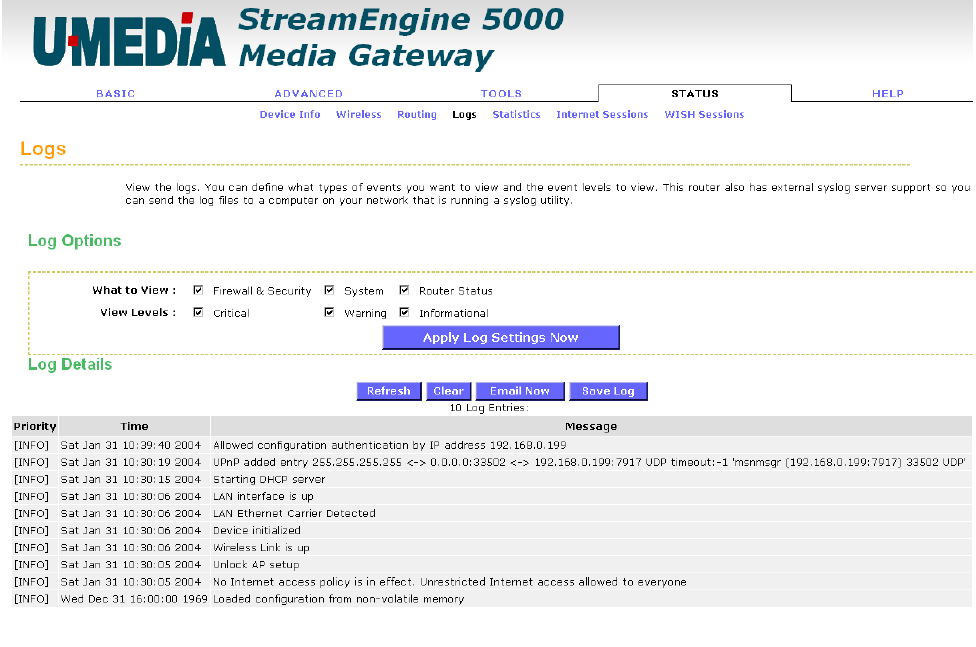
74
Status_Logs
The router automatically logs (records) events of possible interest in its internal memory. If there is not
enough internal memory for all events, logs of older events are deleted, but logs of the latest events
are retained. The Logs option allows you to view the router logs. You can define what types of events
you want to view and the level of events to view. This router also has external Syslog Server support
so you can send the log files to a computer on your network that is running a Syslog utility.
What to View
Select the kinds of events that you want to view.
•
Firewall and Security
•
System
•
Router Status
View Levels
Select the level of events that you want to view.
•
Critical
•
Warning
•
Informational
Apply Log Settings Now

75
Click this button after changing Log Options to make them effective and permanent.
Refresh
Clicking this button refreshes the display of log entries. There may be new events since the last time you
accessed the log.
Clear
Clicking this button erases all log entries.
Email Now
If you provided email information with the Tools → Email Settings screen, clicking the
Email Now
button
sends the router log to the configured email address.
Save Log
Select this option to save the router log to a file on your computer.

76
Status_Statistics
The Statistics page displays all of the LAN, WAN, and Wireless packet transmit and receive statistics.
Sent
The number of packets sent from the router.
Received
The number of packets received by the router.
TX Packets Dropped
The number of packets that were dropped while being sent, due to errors, collisions, or router resource
limitations.
RX Packets Dropped
The number of packets that were dropped while being received, due to errors, collisions, or router resource
limitations.
Collisions
The number of packets that were dropped due to Ethernet collisions (two or more devices attempting to use
an Ethernet circuit at the same time).
Errors
The number of transmission failures that cause loss of a packet. A noisy radio-frequency environment can
cause a high error rate on the wireless LAN.

77

78
Status_
Internet Sessions
The Internet Sessions page displays full details of active Internet sessions through your router. An
Internet session is a conversation between a program or application on a LAN-side computer and a
program or application on a WAN-side computer.
Local
The IP address and, where appropriate, port number of the local application.
NAT
The port number of the LAN-side application as viewed by the WAN-side application.
Internet
The IP address and, where appropriate, port number of the application on the Internet.
Protocol
The communications protocol used for the conversation.
State
State for sessions that use the TCP protocol.
•
NO: None -- This entry is used as a placeholder for a future connection that may occur.
•
SS: SYN Sent -- One of the systems is attempting to start a connection.
•
EST: Established -- the connection is passing data.
•
FW: FIN Wait -- The client system has requested that the connection be stopped.
•
CW: Close Wait -- the server system has requested that the connection be stopped.
•
TW: Time Wait -- Waiting for a short time while a connection that was in FIN Wait is fully closed.
•
LA: Last ACK -- Waiting for a short time while a connection that was in Close Wait is fully closed.
•
CL: Closed -- The connection is no longer active but the session is being tracked in case there are
any retransmitted packets still pending.
Dir
The direction of initiation of the conversation:

79
Out
Initiated from LAN to WAN.
In
Initiated from WAN to LAN.
Priority
The preference given to outbound packets of this conversation by the QoS Engine logic. Smaller numbers
represent higher priority.
Time Out
The number of seconds of idle time until the router considers the session terminated. The initial value of
Time Out depends on the type and state of the connection.
300 seconds
UDP connections.
240 seconds
Reset or closed TCP connections. The connection does not close instantly so that lingering packets can pass
or the connection can be re-established.
7800 seconds
Established or closing TCP connections.
Status_WISH Sessions
The WISH Sessions page displays full details of active local wireless sessions through your router
when WISH has been enabled. A WISH session is a conversation between a program or application
on a wirelessly connected LAN-side computer and another computer, however connected.

80
Originator
The IP address and, where appropriate, port number of the computer that originated a network connection.
Target
The IP address and, where appropriate, port number of the computer to which a network connection has been
made.
Protocol
The communications protocol used for the conversation.
State
State for sessions that use the TCP protocol.
•
NO: None -- This entry is used as a placeholder for a future connection that may occur.
•
SS: SYN Sent -- One of the systems is attempting to start a connection.
•
EST: Established -- the connection is passing data.
•
FW: FIN Wait -- The client system has requested that the connection be stopped.
•
CW: Close Wait -- the server system has requested that the connection be stopped.
•
TW: Time Wait -- Waiting for a short time while a connection that was in FIN Wait is fully closed.
•
LA: Last ACK -- Waiting for a short time while a connection that was in Close Wait is fully closed.
•
CL: Closed -- The connection is no longer active but the session is being tracked in case there are
any retransmitted packets still pending.
Priority
The priority given to packets sent wirelessly over this conversation by the WISH logic. The priorities are:
•
BK: Background (least urgent).
•
BE: Best Effort.
•
VI: Video.
•
VO: Voice (most urgent).
Time Out
The number of seconds of idle time until the router considers the session terminated. The initial value of
Time Out depends on the type and state of the connection.
81
300 seconds
UDP connections.
240 seconds
Reset or closed TCP connections. The connection does not close instantly so that lingering packets can pass
or the connection can be re-established.
7800 seconds
Established or closing TCP connections.
82
Glossary
8
802.11
A family of specifications for wireless local area networks (WLANs) developed by a working group of the
Institute of Electrical and Electronics Engineers (IEEE).
A
Access Control List
ACL. This is a database of network devices that are allowed to access resources on the network.
Access Point
AP. Device that allows wireless clients to connect to it and access the network
ActiveX
A Microsoft specification for the interaction of software components.
Address Resolution Protocol
ARP. Used to map MAC addresses to IP addresses so that conversions can be made in both directions.
Ad-hoc network
Peer-to-Peer network between wireless clients
ADSL
Asymmetric Digital Subscriber Line
Advanced Encryption Standard
AES. Government encryption standard
Alphanumeric
Characters A-Z and 0-9
Antenna
Used to transmit and receive RF signals.
AppleTalk
A set of Local Area Network protocols developed by Apple for their computer systems
AppleTalk Address Resolution Protocol
AARP. Used to map the MAC addresses of Apple computers to their AppleTalk network addresses, so that
conversions can be made in both directions.
Application layer
7th Layer of the OSI model. Provides services to applications to ensure that they can communicate properly
with other applications on a network.
ASCII
American Standard Code for Information Interchange. This system of characters is most commonly used for
text files
Attenuation
The loss in strength of digital and analog signals. The loss is greater when the signal is being transmitted over
long distances.
83
Authentication
To provide credentials, like a Password, in order to verify that the person or device is really who they are
claiming to be
Automatic Private IP Addressing
APIPA. An IP address that that a Windows computer will assign itself when it is configured to obtain an IP
address automatically but no DHCP server is available on the network
B
Backward Compatible
The ability for new devices to communicate and interact with older legacy devices to guarantee interoperability
Bandwidth
The maximum amount of bytes or bits per second that can be transmitted to and from a network device
Basic Input/Output System
BIOS. A program that the processor of a computer uses to startup the system once it is turned on
Baud
Data transmission speed
Beacon
A data frame by which one of the stations in a Wi-Fi network periodically broadcasts network control data to
other wireless stations.
Bit rate
The amount of bits that pass in given amount of time
Bit/sec
Bits per second
BOOTP
Bootstrap Protocol. Allows for computers to be booted up and given an IP address with no user intervention
Bottleneck
A time during processes when something causes the process to slowdown or stop all together
Broadband
A wide band of frequencies available for transmitting data
Broadcast
Transmitting data in all directions at once
Browser
A program that allows you to access resources on the web and provides them to you graphically
C
Cable modem
A device that allows you to connect a computer up to a coaxial cable and receive Internet access from your
Cable provider
CardBus
84
A newer version of the PC Card or PCMCIA interface. It supports a 32-bit data path, DMA, and consumes less
voltage
CAT 5
Category 5. Used for 10/100 Mbps or 1Gbps Ethernet connections
Client
A program or user that requests data from a server
Collision
When do two devices on the same Ethernet network try and transmit data at the exact same time.
Cookie
Information that is stored on the hard drive of your computer that holds your preferences to the site that gave
your computer the cookie
D
Data
Information that has been translated into binary so that it can be processed or moved to another device
Data Encryption Standard
Uses a randomly selected 56-bit key that must be known by both the sender and the receiver when
information is exchanged
Database
Organizes information so that it can be managed updated, as well as easily accessed by users or
applications.
Data-Link layer
The second layer of the OSI model. Controls the movement of data on the physical link of a network
DB-25
A 25 ping male connector for attaching External modems or RS-232 serial devices
DB-9
A 9 pin connector for RS-232 connections
dBd
Decibels related to dipole antenna
dBi
Decibels relative to isotropic radiator
dBm
Decibels relative to one milliwatt
Decrypt
To unscramble an encrypted message back into plain text
Default
A predetermined value or setting that is used by a program when no user input has been entered for this
value or setting
Demilitarized zone
85
DMZ: A single computer or group of computers that can be accessed by both users on the Internet as well as
users on the Local Network, but that is not protected by the same security as the Local Network.
DHCP
Dynamic Host Configuration Protocol: Used to automatically assign IP addresses from a predefined pool of
addresses to computers or devices that request them
Digital certificate:
An electronic method of providing credentials to a server in order to have access to it or a network
Direct Sequence Spread Spectrum
DSSS: Modulation technique used by 802.11b wireless devices
DMZ
"Demilitarized Zone". A computer that logically sits in a "no-mans land" between the LAN and the WAN. The
DMZ computer trades some of the protection of the router's security mechanisms for the convenience of being
directly addressable from the Internet.
DNS
Domain Name System: Translates Domain Names to IP addresses
Domain name
A name that is associated with an IP address
Download
To send a request from one computer to another and have the file transmitted back to the requesting
computer
DSL
Digital Subscriber Line. High bandwidth Internet connection over telephone lines
Duplex
Sending and Receiving data transmissions at the sane time
Dynamic DNS service
Dynamic DNS is provided by companies to allow users with Dynamic IP addresses to obtain a Domain Name
that will always by linked to their changing IP address. The IP address is updated by either client software
running on a computer or by a router that supports Dynamic DNS, whenever the IP address changes
Dynamic IP address
IP address that is assigned by a DHCP server and that may change. Cable Internet providers usually use this
method to assign IP addresses to their customers.
E
EAP
Extensible Authentication Protocol
Email
Electronic Mail is a computer-stored message that is transmitted over the Internet
Encryption
Converting data into cyphertext so that it cannot be easily read
Ethernet
The most widely used technology for Local Area Networks.
86
F
Fiber optic
A way of sending data through light impulses over glass or plastic wire or fiber
File server
A computer on a network that stores data so that the other computers on the network can all access it
File sharing
Allowing data from computers on a network to be accessed by other computers on the network with different
levels of access rights
Firewall
A device that protects resources of the Local Area Network from unauthorized users outside of the local
network
Firmware
Programming that is inserted into a hardware device that tells it how to function
Fragmentation
Breaking up data into smaller pieces to make it easier to store
FTP
File Transfer Protocol. Easiest way to transfer files between computers on the Internet
Full-duplex
Sending and Receiving data at the same time
G
Gain
The amount an amplifier boosts the wireless signal
Gateway
A device that connects your network to another, like the internet
Gbps
Gigabits per second
Gigabit Ethernet
Transmission technology that provides a data rate of 1 billion bits per second
GUI
Graphical user interface
H
H.323
A standard that provides consistency of voice and video transmissions and compatibility for videoconferencing
devices
Half-duplex
Data cannot be transmitted and received at the same time
Hashing
87
Transforming a string of characters into a shorter string with a predefined length
Hexadecimal
Characters 0-9 and A-F
Hop
The action of data packets being transmitted from one router to another
Host
Computer on a network
HTTP
Hypertext Transfer Protocol is used to transfer files from HTTP servers (web servers) to HTTP clients (web
browsers)
HTTPS
HTTP over SSL is used to encrypt and decrypt HTTP transmissions
Hub
A networking device that connects multiple devices together
I
ICMP
Internet Control Message Protocol
IEEE
Institute of Electrical and Electronics Engineers
IGMP
Internet Group Management Protocol is used to make sure that computers can report their multicast group
membership to adjacent routers
IIS
Internet Information Server is a WEB server and FTP server provided by Microsoft
IKE
Internet Key Exchange is used to ensure security for VPN connections
Infrastructure
In terms of a wireless network, this is when wireless clients use an Access Point to gain access to the network
Internet
A system of worldwide networks which use TCP/IP to allow for resources to be accessed from computers
around the world
Internet Explorer
A World Wide Web browser created and provided by Microsoft
Internet Protocol
The method of transferring data from one computer to another on the Internet
Internet Protocol Security
IPsec provides security at the packet processing layer of network communication
Internet Service Provider
88
An ISP provides access to the Internet to individuals or companies
Intranet
A private network
Intrusion Detection
A type of security that scans a network to detect attacks coming from inside and outside of the network
IP
Internet Protocol
IP address
A 32-bit number, when talking about Internet Protocol Version 4, that identifies each computer that transmits
data on the Internet or on an Intranet
IPsec
Internet Protocol Security
IPX
Internetwork Packet Exchange is a networking protocol developed by Novel to enable their Netware clients
and servers to communicate
ISP
Internet Service Provider
J
Java
A programming language used to create programs and applets for web pages
K
Kbps
Kilobits per second
Kbyte
Kilobyte
L
L2TP
Layer 2 Tunneling Protocol
LAN
Local Area Network
Latency
The amount of time that it takes a packet to get from the one point to another on a network. Also referred to as
delay
LED
Light Emitting Diode
Legacy
Older devices or technology
Local Area Network
89
A group of computers in a building that usually access files from a server
LPR/LPD
"Line Printer Requestor"/"Line Printer Daemon". A TCP/IP protocol for transmitting streams of printer data.
M
MAC Address
A unique hardware ID assigned to every Ethernet adapter by the manufacturer.
Mbps
Megabits per second
MDI
Medium Dependent Interface is an Ethernet port for a connection to a straight-through cable
MDIX
Medium Dependent Interface Crossover, is an Ethernet port for a connection to a crossover cable
MIB
Management Information Base is a set of objects that can be managed by using SNMP
Modem
A device that Modulates digital signals from a computer to an analog signal in order to transmit the signal over
phone lines. It also Demodulates the analog signals coming from the phone lines to digital signals for your
computer
MPPE
Microsoft Point-to-Point Encryption is used to secure data transmissions over PPTP connections
MTU
Maximum Transmission Unit is the largest packet that can be transmitted on a packet-based network like the
Internet
Multicast
Sending data from one device to many devices on a network
N
NAT
Network Address Translation allows many private IP addresses to connect to the Internet, or another network,
through one IP address
NetBEUI
NetBIOS Extended User Interface is a Local Area Network communication protocol. This is an updated
version of NetBIOS
NetBIOS
Network Basic Input/Output System
Netmask
Determines what portion of an IP address designates the Network and which part designates the Host
Network Interface Card
A card installed in a computer or built onto the motherboard that allows the computer to connect to a network
90
Network Layer
The third layer of the OSI model which handles the routing of traffic on a network
Network Time Protocol
Used to synchronize the time of all the computers in a network
NIC
Network Interface Card
NTP
Network Time Protocol
O
OFDM
Orthogonal Frequency-Division Multiplexing is the modulation technique for both 802.11a and 802.11g
OSI
Open Systems Interconnection is the reference model for how data should travel between two devices on a
network
OSPF
Open Shortest Path First is a routing protocol that is used more than RIP in larger scale networks because
only changes to the routing table are sent to all the other routers in the network as opposed to sending the
entire routing table at a regular interval, which is how RIP functions
P
Password
A sequence of characters that is used to authenticate requests to resources on a network
Personal Area Network
The interconnection of networking devices within a range of 10 meters
Physical layer
The first layer of the OSI model. Provides the hardware means of transmitting electrical signals on a data
carrier
Ping
A utility program that verifies that a given Internet address exists and can receive messages. The utility sends
a control packet to the given address and waits for a response.
PoE
Power over Ethernet is the means of transmitting electricity over the unused pairs in a category 5 Ethernet
cable
POP3
Post Office Protocol 3 is used for receiving email
Port
A logical channel endpoint in a network. A computer might have only one physical channel (its Ethernet
channel) but can have multiple ports (logical channels) each identified by a number.
PPP
Point-to-Point Protocol is used for two computers to communicate with each over a serial interface, like a
phone line
91
PPPoE
Point-to-Point Protocol over Ethernet is used to connect multiple computers to a remote server over Ethernet
PPTP
Point-to-Point Tunneling Protocol is used for creating VPN tunnels over the Internet between two networks
Preamble
Used to synchronize communication timing between devices on a network
Q
QoS
Quality of Service
R
RADIUS
Remote Authentication Dial-In User Service allows for remote users to dial into a central server and be
authenticated in order to access resources on a network
Reboot
To restart a computer and reload it's operating software or firmware from nonvolatile storage.
Rendezvous
Apple's version of UPnP, which allows for devices on a network to discover each other and be connected
without the need to configure any settings
Repeater
Retransmits the signal of an Access Point in order to extend it's coverage
RIP
Routing Information Protocol is used to synchronize the routing table of all the routers on a network
RJ-11
The most commonly used connection method for telephones
RJ-45
The most commonly used connection method for Ethernet
RS-232C
The interface for serial communication between computers and other related devices
RSA
Algorithm used for encryption and authentication
S
Server
A computer on a network that provides services and resources to other computers on the network
Session key
An encryption and decryption key that is generated for every communication session between two computers
Session layer
The fifth layer of the OSI model which coordinates the connection and communication between applications
on both ends
92
Simple Mail Transfer Protocol
Used for sending and receiving email
Simple Network Management Protocol
Governs the management and monitoring of network devices
SIP
Session Initiation Protocol. A standard protocol for initiating a user session that involves multimedia content,
such as voice or chat.
SMTP
Simple Mail Transfer Protocol
SNMP
Simple Network Management Protocol
SOHO
Small Office/Home Office
SPI
Stateful Packet Inspection
SSH
Secure Shell is a command line interface that allows for secure connections to remote computers
SSID
Service Set Identifier is a name for a wireless network
Stateful inspection
A feature of a firewall that monitors outgoing and incoming traffic to make sure that only valid responses to
outgoing requests are allowed to pass though the firewall
Subnet mask
Determines what portion of an IP address designates the Network and which part designates the Host
Syslog
System Logger -- a distributed logging interface for collecting in one place the logs from different sources.
Originally written for UNIX, it is now available for other operating systems, including Windows.
T
TCP
Transmission Control Protocol
TCP Raw
A TCP/IP protocol for transmitting streams of printer data.
TCP/IP
Transmission Control Protocol/Internet Protocol
TFTP
Trivial File Transfer Protocol is a utility used for transferring files that is simpler to use than FTP but with less
features
Throughput
93
The amount of data that can be transferred in a given time period
Traceroute
A utility displays the routes between you computer and specific destination
U
UDP
User Datagram Protocol
Unicast
Communication between a single sender and receiver
Universal Plug and Play
A standard that allows network devices to discover each other and configure themselves to be a part of the
network
Upgrade
To install a more recent version of a software or firmware product
Upload
To send a request from one computer to another and have a file transmitted from the requesting computer to
the other
UPnP
Universal Plug and Play
URL
Uniform Resource Locator is a unique address for files accessible on the Internet
USB
Universal Serial Bus
UTP
Unshielded Twisted Pair
V
Virtual Private Network
VPN: A secure tunnel over the Internet to connect remote offices or users to their company's network
VLAN
Virtual LAN
Voice over IP
Sending voice information over the Internet as opposed to the PSTN
VoIP
Voice over IP
W
Wake on LAN
Allows you to power up a computer though it's Network Interface Card
WAN
94
Wide Area Network
WCN
Windows Connect Now. A Microsoft method for configuring and bootstrapping wireless networking hardware
(access points) and wireless clients, including PCs and other devices.
WDS
Wireless Distribution System. A system that enables the interconnection of access points wirelessly.
Web browser
A utility that allows you to view content and interact with all of the information on the World Wide Web
WEP
Wired Equivalent Privacy is security for wireless networks that is supposed to be comparable to that of a wired
network
Wide Area Network
The larger network that your LAN is connected to, which may be the Internet itself, or a regional or corporate
network
Wi-Fi
Wireless Fidelity
Wi-Fi Protected Access
An updated version of security for wireless networks that provides authentication as well as encryption
Wireless ISP
A company that provides a broadband Internet connection over a wireless connection
Wireless LAN
Connecting to a Local Area Network over one of the 802.11 wireless standards
WISP
Wireless Internet Service Provider
WLAN
Wireless Local Area Network
WPA
Wi-Fi Protected Access. A Wi-Fi security enhancement that provides improved data encryption, relative to
WEP.
X
xDSL
A generic term for the family of digital subscriber line (DSL) technologies, such as ADSL, HDSL, RADSL, and
SDSL.
Y
Yagi antenna
A directional antenna used to concentrate wireless signals on a specific location